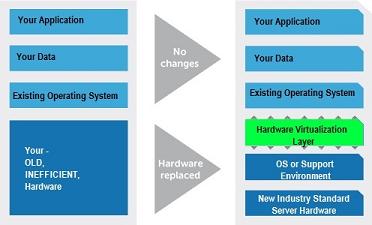Cross Platform Virtualization
OK, so what is "Cross Platform Virtualization"?

If you have business critical applications running on hardware that is no longer being manufactured this is an important option to consider.
This complex term is the correct way of describing a software based computer system emulator. There are many examples of these interesting tools that exist. Some of the first were created by IBM to allow the execution of business critical programs developed for earlier systems on their latest and greatest mainframes.
This diagram gives a VERY high level visual presentation of what happens in cross platform virtualization. The green area in the diagram shows where all the heavy lifting is being done. This special application programming interface sits between your existing operating system (and programs which were previously running on the older, inefficient hardware) and the new industry standard hardware of your new server. Your existing operating system and programs see this interface as the "old hardware" and no changes need to be made to your operating system or programs.
There are environments and frameworks specific to the implementation of emulators which are very flexible, including QEMU, SimH, Synopsys, Trango, Simics, Quick Transit, OPVsim, Hercules, GXemul, and others. For example, SimH currently supports many different emulators, such as:
- Data General Nova, Eclipse
- Digital Equipment Corporation PDP-1, PDP-4, PDP-7, PDP-8, PDP-9, PDP-10, PDP-11, PDP-15, VAX
- GRI Corporation GRI-909, GRI-99
- IBM 1401, 1620, 1130, 7090/7094, System 3
- Interdata (Perkin-Elmer) 16b and 32b systems
- Hewlett-Packard 2114, 2115, 2116, 2100, 21MX, 1000
- Honeywell H316/H516
- MITS Altair 8800, with both 8080 and Z80
- Royal-Mcbee LGP-30, LGP-21
- Scientific Data Systems SDS 940
- SWTP 6800
There are companies that have developed specific, high performance cross platform virtual implementations. These companies include Stromasys, AVT and EmuVM in the Digital Equipment Corporation arena. Stromasys is the oldest of these and to some extent the pioneer in the current market -- they originally created a PDP-11 emulator followed by VAX and then Alpha emulators. AVT and EmuVM both have VAX and Alpha emulators. Stromasys has also introduced SUN Sparc and HP 3000 emulators.
So why consider implementing cross platform virtualized systems?
As equipment gets older, it is necessary to consider the issues:
- Continued high priced hardware support costs
- Continued energy costs of inefficient systems
- Continued cooling of inefficient systems
- Cost of floor space for large legacy systems
- Access to people who are competent to maintain and repair legacy hardware
- Access to spare parts
Cross platform virtualized systems address all of these issues:
- Industry standard hardware under warranty
- Lower energy requirement of efficient new hardware
- Lower cooling requirement of new hardware
- Smaller footprint than legacy systems
- Readily available systems can be replaced or upgraded
We work with you to evaluate the benefit of moving to new hardware while maintaining your existing software without the need to change a line of code or recompile or relink your application.


